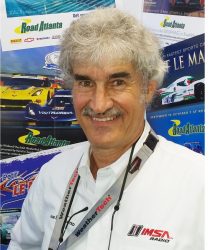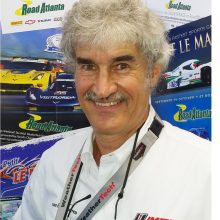Ask a pro
Receive advice directly from today’s top stars


Jeremy Shaw
Team USA Scholarship President
Jeremy Shaw, President of the Team USA Scholarship and leading TV and radio announcer, is the latest online driving instructor for SAFEisFAST.com.
A motor racing writer and broadcaster for more than 40 years, Shaw is the founder of the Team USA Scholarship which has provided opportunities for young American drivers since 1990.
Shaw began his career reporting for a number of publications such as Motoring News and Autosport, before moving to the US to become Editorial Director for On Track Magazine in 1985. Shaw went on to become a commentator for CART/Champ Car between 1993-2007.
Shaw founded the Team USA Scholarship in 1990, and continues to run the initiative that has seen the likes of Jimmy Vasser, Bryan Herta, and Josef Newgarden graduate and on to become race winners in a number of top-level race series.
Jeremy Shaw answers your questions!
-
Henry Dillmund
Hi Jeremy, when you are scouting young racing drivers, what is the most important element you look for in a young racer? For example, do you specifically look for raw speed, overtaking, tyre management etc?




Hello Henry, thank you for your question. I’m looking for the complete package. Drivers need to be well rounded in order for them to have any chance of making it to the top in this sport. They need to be fast, of course, but perhaps more importantly they need to be ambitious and open-minded. They must be willing to take criticism and have a passion to learn.
I’ve seen several youngsters come out of karts, for example, and think they know everything. They need to understand that achieving success in karting doesn’t necessarily translate into a top-line car racing career. I’m looking for people who WANT to learn, starting with the basics and then gaining knowledge with experience. All of the clichés are true! There is no substitute for experience in this sport, and the best young drivers can learn a great deal from making mistakes. They need to apply themselves, work hard, and ask questions. Then ask more questions. And take one step at a time. I’m a firm believer in youngsters spending two years at every level on the ladder — and not moving up the ladder too soon. Year One is to learn, and Year Two is to win. The competition gets tougher as drivers move up the ladder, so there’s not much point in stepping up a level until they’ve proven themselves as winners. Lewis Hamilton is the model for that — two years in Formula Renault, two years in Formula 3 and two years in GP2. More recently in the U.S., Spencer Pigot took the same approach before graduating into the Verizon IndyCar Series. The real key to success is being ready to take advantage of opportunities as they present themselves, and experience is critical.
-
Bethan Whittaker
How important is it for a young driver to bring money to the table to succeed? If a young driver doesn’t have sponsors or backing, is there a hope for their career?




There’s no getting away from the fact that success comes much more easily if a young driver has the financial support to gain the necessary experience and learn as he or she progresses up the ladder! But there’s so much more to the sport than that. Because I’ve been based in the U.S. for the past 30-odd years, I’m going to cite a few examples of drivers who have made — or are making — successful careers in North America without a background of wealth: Tony Kanaan, Memo Gidley, AJ Allmendinger, Andy Lally and Trent Hindman. All of them made it to the top because they were prepared to work hard and not take “no” for an answer! There are plenty more who have made it the same way, too.
Going back much further than that, in the 1970s two ambitious youngsters from Dublin, Ireland, decided they wanted to become racing drivers. Neither had any money, nor did they have any background in the sport — or, indeed, any real clue about what it took to reach the top. But they realized they needed to make some money. So they headed to Australia, where they undertook manual labor for 18 months. They lived in the Outback, where there was hardly any opportunity to spend money even if they wanted to, so when they returned to Europe they each had enough money to buy a Formula Ford car and start racing. Against the odds, both of them made it to Formula 1. Their names are Derek Daly and David Kennedy. Now, I’m willing to admit such a stunt might not be possible in this day and age, but my point is that they made personal sacrifices and worked their tails off to get where they wanted to go.
-
Dave
Hi Jeremy, you’ve worked with lots of great drivers in your role with Team USA, but which one has been the most talented in your eyes and why?




Every single one of them had talent, otherwise they wouldn’t have been selected, but I suppose there are a few who stood out above the rest. It sounds easy to say it now but Josef Newgarden would certainly rank in that category. Ditto JR Hildebrand and Dane Cameron. All three were ambitious, dedicated and instantly on the pace in everything they drove. They were intelligent and willing and able to listen and learn. In short, they were outstanding both in and out of the car.
I hope it’s not too early to classify Oliver Askew and Neil Verhagen in with them, too. Oliver has his eyes set on an IndyCar career, while Neil has the F1 dream…and, thankfully, will be supported again by Red Bull next year in the Formula Renault Eurocup. Both young men have everything it takes to be successful; now they just need to keep on working hard and have a little bit of luck on their side.
-
Philip Jameson
I don’t have much background in reporting, but I really want to get into commentating on racing, so what would you recommend for someone looking to go down that path?




Well, Philip, I had no background in reporting or commentating when I first started out either! What I did have — and still do — is a passion for the sport. I spent as much time as possible at local race tracks — Silverstone in my case — getting to know the people, reading all the magazines and learning as much as I could about the sport. In many ways it’s easier now, because of the availability of information on the Internet, but in some ways it’s more difficult because the same information is available to more people, so it’s harder to stand out!
In my opinion it’s important to take things one step at a time, to pay your dues. I spent at least two or three years attended the races and writing “mock” reports — purely for myself — while I was at school before I plucked up the courage and approached one of the editors at a racing magazine.
Funnily enough, I never had any intention of becoming a commentator. I was quite happy in the background, feeding information to people like Ian Titchmarsh and Murray Walker in their commentary booths — and later, after I had moved to the U.S., to Paul Page at ABC Sports. It was Paul who gave me my first opportunity to serve as a commentator, and I shall remain forever grateful.
-
David Phillips
What is the proper way to express your frustration at missing a downshift coming down Beartooth Pass?




Good question, David. I certainly hope by now, after all these years, you have come up with something rather better than “Whoops!” (To the uninitiated, I was in the passenger seat, perusing the maps — or perhaps taking a brief nap — while traveling along one of the most scenic roads in all of North America when I heard the driver, a certain Mr. Phillips, utter a discreet “whoops”…then slam on the brakes and jam the steering hard left to narrowly prevent us from plummeting off the side of a mountain!)
-
JD King
Jeremy and thank you for taking my question. You probably get asked this question a lot… What chance is there for un-funded drivers to win a Team USA scholarship?
Note: I have driven older Formula Fords for over 25 years, and doing so one-handed since losing my left arm in an industrial accident back in ’97.
Both of my sons have grown up around SCCA racing and both have their competition licenses.
Max (21) having just finished the SCCA Runoffs in a Gen3 Spec Racer Ford, running as high as 8th before finishing 12th. His first time at the track with zero test time and only his 5th time driving that class. He was tending to his engineering studies and mid-terms.
He owns 2 lap records, Watkins Glen and NJMP, and has won and podium finished all but one race weekend. He started driving my old Zink Z10 FF and has always run up front, winning most times.
Jacob (16) has just started racing and nearly set a lap record on his way to a win in a borrowed Gen2 SRF last month. His first time in a purpose built car (he doesn’t fit in the FF car, too tall and feet too big). He’s raced an old Datsun 240Z and received his racing license in an E30 BMW.
Both boys have qualified for the Nissan GT Academy with Max advancing to the finals at Silverstone. He was fastest there but was overlooked for an Aussie chap for marketing reasons. Jacob could not attend as he was too young. Anyway, your valuable advice is much desired.
Thank you, JD



I’ve always said that available funding has nothing to do with the selection process, and I believe our actions over the years back up that statement. What does matter is the skill-set and, perhaps more than anything else, the attitude.
In order to be selected for the Team USA Scholarship, drivers need to be outstanding, both in and out of the car. Bear in mind the winners will be representing their country and carrying the colors of many prestigious names and sponsors. They are also tasked with continuing a legacy that has been established over close to 30 years. I’m looking to help the best of the best — that’s why, I believe, the program has been so successful and has endured for such a long time.
I have a network of people who are on the look-out for talented youngsters who are competing at the grassroots of the sport. We’re looking for winners, and so naturally I focus my attentions on series with a winning heritage.
Michai Stephens and Aaron Jeansonne are two good examples from recent years. Both decided at a young age that they wanted to become racing drivers. Neither had any funding to speak of, nor any background in the sport, but they made up for it in passion. They saved up enough money to enroll in a race driving school — in Michai’s case Skip Barber, which, sadly, is no longer around, and Aaron at the Lucas Oil School of Racing. Both impressed their instructors right away with their speed and, more importantly, their propensity to learn.When Michai first traveled to the UK to compete at the Formula Ford Festival and the Walter Hayes Trophy, his total racing experience amounted to a handful of Skip Barber race weekends. That was it. No karting or anything else. He was involved in a couple of incidents at Brands Hatch, neither of his making, but he rebounded at Silverstone and finished third in the Grand Final — in very tricky conditions — from a field of over 110 Formula Ford drivers. His performance was astonishing. Ask Dario Franchitti, who was at Silverstone that day coaching a couple of Scottish youngsters!
It’s true, Michai hasn’t been racing this year but he continues to look for opportunities and I believe has no intention of giving up! Aaron, too, is working hard to keep his dream alive.
-
John Duke
In your considered opinion what will it requite before we see a competitive American driver placed in a competitive team in F1 and when do you think this is possible? Or said another way, why haven’t we seen more American drivers in Formula One?




Hello John, that’s a very good question, and the only easy answer is to say that it will happen as soon as a wealthy benefactor decides he want to take an American driver all the way to F1! I’m sorry if that sounds facetious, but it’s true. F1 is the pinnacle of the sport. There is room only for the best of the best. It’s also extremely (ridiculously?) expensive.
For the last few years and for the foreseeable future, there are 20 seats available in F1. There are always nay-sayers who claim that some of the drivers in F1 are only there because they bought their way in but I think that’s being disingenuous. I would say all 20 drivers who are currently competing in F1 have thoroughly earned the right to be there.
So why are there no Americans right now in F1? Well, quite honestly, it’s because we haven’t produced anyone in recent years who has proven themselves to be deserving of an F1 drive. None has won regularly at every level on the way to F1. Alexander Rossi came close and tried hard — and his family made tremendous sacrifices — but, ultimately, it wasn’t quite enough. I believe Josef Newgarden might have been able to make it. He had all the attributes except one: the financial wherewithal….
On the other hand, there are plenty of American drivers in the Verizon IndyCar Series, which is, arguably, even more competitive than F1 — certainly in terms of the equipment that’s available to everyone. I think many drivers regard the IndyCar series as a viable alternative to F1, and why not? There’s no doubt it’s more attainable, and there is a structure in place — the Mazda Road to Indy Presented by Cooper Tires — to help talented drivers make their way along that route.
-
Paul Carter
How important is it for a young driver to progress through traditional ladder programmes like Mazda Road to Indy? Is there hope for a driver outside of this system?




Well, Paul, it depends upon what goals a driver sets out for himself. If his or her goal is to race in the Verizon IndyCar Series and the Indianapolis 500, absolutely the Mazda Road to Indy is the way to go. As I mentioned in a previous answer, the winners at every level earn substantial scholarships to help them progress to the next level. There is no other driver development like it in the world. Just look at this year’s Indy 500, in which 24 of the 33 starters were graduates of the Mazda Road to Indy. It works.
Spencer Pigot is the poster boy. He doesn’t come from a particularly wealthy background, yet he won four Mazda scholarships which took him all the way from karting to the Indy 500, and he now has a full-time drive with Ed Carpenter Racing. He wouldn’t be there without the Mazda Road to Indy.
Last year’s Team USA Scholarship winner, Oliver Askew, is another good example. He earned an invitation to the Mazda Road to Indy USF2000 $200K Scholarship Shootout in 2016, won it, took the $200,000 scholarship into the Cooper Tires USF2000 Championship Powered by Mazda, won that too and now has another $325,000 Mazda Scholarship to move onto the next step, the Pro Mazda Championship Presented by Cooper Tires, in 2018….
The Mazda Road to Indy is unique in terms of open-wheel racing — there’s nothing close in Europe (although various European feeder series, including Formula Ford 1600 in the UK, do offer a place in the MRTI Scholarship Shootout), nor anything formal that leads towards F1 — but there are a few programs aimed at sports car racing. Ginetta, for example, has a proven ladder in place. And for drivers who have their sights set on something other than F1 or IndyCar, including sports cars, there are plenty of other options available. Having said that, virtually all of the top-level drivers in sports cars began their careers driving open-wheel cars. That’s no coincidence. It’s because that’s where the talent prospers. And a solid grounding in open-wheel competition can open up many doors to the sports car world too…
-
Alberto Fonseca
I’m a club racer and fan of sports car racing (IMSA). I always enjoy your commentating during the broadcasts and wanted to get your perspective on how we can grow the audience for road racing in North America. I’d like to see the types of turnouts and following we see in Australia for V8 Supercars for example and other road racing series around the world. How do we get there in your opinion?




Hi Alberto, and thank you. Once again I wish there was an easy answer, a magic bullet. But there really isn’t. I certainly wouldn’t claim to be an expert on marketing, far from it, but I think the biggest difference between somewhere like Australia, or much of Europe, and North America is that motor racing is already ingrained in some way into the culture. Back in the 1960s and ’70s, when television began to have an influence on the world, motor racing received some fairly substantial exposure in those countries and their drivers enjoyed a lot of international successes. The sport received extensive coverage in the newspapers and on TV. But America was different. I’ll admit, I didn’t move to the U.S. until the mid ’80s but back then there was precious little “mainstream” coverage of the sport. And even the timely dissemination of information about the sport, in magazines like On Track or National Speed Sport News, was logistically difficult because of the vastness of the continent.
Nowadays, of course, its much easier to share information because of the Internet, but that also presents more of a challenge because of the sheer wealth of information that’s available. There is a great deal of “competition” for people’s time.
I think it’s fair to say the heyday of road racing in North America was in the 1980s, when CART/Champ Car was at its height. The quality of the racing was sensational, the standard was extremely high and, crucially, the manufacturers were spending a lot of money on advertising. The “Mansell factor” was huge too, because F1 has always had a cult following in the U.S. and the fact that the reigning F1 world champion, a “people’s champion,” was racing in the States was a major draw.
How do we get back to that level of fervor? Honestly, it will be difficult if not impossible, but I do think road racing is on the right path in the U.S. The IMSA WeatherTech SportsCar Championship is in rude health, with sensible and relatively cost-effective technical regulations, and I believe it will continue to grow. There is strength and depth in the IndyCar series, too, and even NASCAR — which is facing a great many challenges right now — is looking to increase its focus on road racing.
-
Dan Smith
What is your opinion of the Halo that they are bringing to F1 next year?




Personally, I don’t like it. Goodness knows, I’m all for making the sport safer. I have lived through an era when many people died in our sport. They were tragic times. Looking back, it was pure ignorance that was largely to blame; we simply didn’t know any better. Everyone did the best they could at the time to make the cars as safe as they could, but the technology simply wasn’t available. Thankfully, times have changed. Drastically. The cars are now infinitely safer than they were because of the advances in technology. But the fact of the matter is that motor racing will always be dangerous. Perhaps that’s why some people are drawn to it? They see the danger as attraction. I don’t believe I feel that way. I am drawn by the challenge of competing, the intensity, the people. But I believe aesthetics are important too. I think the Halo is ugly and I don’t believe it will prevent drivers from being injured. Accidents will always happen and, unfortunately, there will be injuries. But everyone I know in this sport understands those risks. They are prepared to take those risks. If not, they should find something else to do with their lives.
-
Marcus Taggart
Hey Jeremy, really impressive work you do with Team USA!
Obviously with Josef Newgarden winning IndyCar this year it reflects very well on the scholarship. Do you think that the academy will produce more champions in the future, and if so who do you think it will be? Thanks.



Thank you, Marcus. The scholarship has been helping young drivers since 1990. The vast majority of alumni have gone on to achieve success at the top levels and I see no reason why that should change. I’ll admit, the sport is a lot more expensive now than it used to be, in relative terms, which is a shame and undoubtedly makes it more difficult to achieve success, but I think the same principles apply. Hard work, dedication, discipline, patience and perseverance — and more hard work — are still the cornerstones for making a career in this sport.
As such, I believe any of the recent Team USA Scholarship winners, and those in the future, are capable of becoming champions at the top level. If I didn’t think so, I would stop tomorrow. And I have no intention of stopping now!
-
Alberto Fonseca
How much do you think the current broadcasting partnerships help or hurt the promotion of the sport? Myself, I’m a cord-cutter and watch the full replays on YouTube when they’re published because they’re not always available on IMSA.com in the US.




I’m afraid I don’t really understand the question. Again, I’m no promoter but I presume broadcasting partnerships are a necessity. Ideally, of course, the sanctioning bodies would love to be paid by the major networks to showcase their racing. But because of the competition for air-time, that simply isn’t feasible for the majority of championships, so they need to forge “partnerships” and buy the air-time. Someone has to pay for that.
Personally, most of the races I watch on TV are on delay. Even when I’m home, for example, I “tape” the F1 races, plus qualifying, and watch the shows — at my leisure — on the DVR. Of course I would prefer to watch them “live” but I don’t mind not doing so. I will happily go out of my way to avoid seeing the results, so I gain the same satisfaction as if I was watching in real time. Same with many other series. From my perspective, IMSA has more options for fans than most because the races are always available, sooner or later, on IMSA Radio and imsa.tv. Plus, it’s always free!
-
Martin Sutcliffe-Davies
Hey Jeremy, I have a few questions if that is okay. What is your impression of the new Formula 3 Americas series coming to North America next year? With this and US F4 coming into place, do you think there will be a Formula 2 series in the States one day? And finally, do you think this will create a better route for American racers to F1, as the majority follow the Mazda Road to Indy path instead of going for F1? Many thanks and keep up the brilliant job!




Hi Martin, no problem. To be perfectly honest, I’m not sure how F3 will fit in. I presume the hope is to have an F2 series in the future, but I must admit I don’t really see the point.
As I have mentioned already, the Mazda Road to Indy Presented by Cooper Tires is already established. Each step is clearly defined. The cars are all modern. They offer a sensible progression in terms of performance and cost. All of the events are with IndyCar. The ladder offers a scholarship-funded path all the way from the grassroots to the top in North America. It works.
I can see the attraction of F4, because it is currently quite cost-effective (and I hope remains so), but if youngsters want to race in F1, in my book they should be competing in Europe, where they can learn many of the F1 tracks and compete in front of the F1 teams. The problem is that there is no real reward at the end of the day, other than the possible lure of an F1 “reserve driver” contract…most of which, I’m told, cost a great deal of money to buy (although of course there are exceptions to that general rule)!
-
TD
Is there really a difference in the way Europeans race and the way Americans go about it? Do you really feel there is any really hope for an American World Champion?




Two very different questions there, TD. I’ve spent half of my life absorbed in the European culture of racing and half of it in the United States, and there are certainly differences in the way races are run on the two different continents — separate philosophies, if you like — but the level of intensity is pretty similar. The desire to win remains the same.
The biggest difference is perhaps in regard to the regulations surrounding on-track incidents. In Europe, the preference is to retain the gaps between the cars. I’m referring in particular to the Code 60 or Virtual Safety Car procedures, which, in effect, neutralize the race following an incident and allow any gaps that had opened up between the cars to remain when the race is resumed. Contrast that to North America where full-course caution periods allow the competitors to bunch up behind a Safety Car, thereby effectively eliminating some of the advantages that had been accrued prior to the interruption. Personally, I have come to appreciate the North American way of doing things. Why? Because I believe motor racing is an amalgam of sport and entertainment. I like the fact that the race effectively starts afresh when the Safety Car is withdrawn. I believe it’s more attractive to audiences and creates additional excitement. All good, in my opinion.
Do I think an American can win the Formula 1 World Championship (assuming that’s what you’re asking)? As I’ve outlined already in an earlier answer, I see no reason why not. It will take a massive commitment of time and money, but anything is possible if the driver has the requisite levels of personality, desire and determination.
-
AJ Ramirez
Hey Jeremy, I just wondered what has been your favourite motor race of all time that you have commentated on and why?




Hi AJ. Boy, that’s a tough one. Over the years I have been fortunate enough to cover many, many great races both as a writer and a commentator, and I always believe the next one is going to be the best. Indeed, I can hardly wait for the Rolex 24 At Daytona in January!
I didn’t actually commentate on them at the time but there were countless Formula Ford races in the 1970s and ’80s, particularly at Silverstone, that were sensational to watch with packs of cars and top-quality drivers slipstreaming around, ducking and diving as they jockeyed for position entering Woodcote Corner on the final lap. Fantastic fun.
I have many wonderful memories from the CART/Champ Car days, too. Those cars, with the powerful turbocharged engines, fairly basic aerodynamics (at least in today’s terms) and tremendous drivers were incredible to watch, especially on the ovals. There were a couple of epic races at Michigan, for example, especially with the Handford Device rear wing that made it virtually impossible to break away. Awfully dangerous but amazing to behold.
Also, I’ll never forget working at a couple of the Australian Grand Prix Formula 1 races a decade or so ago for Network Ten, particularly when I sat alongside the legend that is Murray Walker. I had been lucky enough to sit alongside Murray and James Hunt in their commentary booth on numerous occasions before I moved to the States, lap-charting the races and passing along information to them in note form. It was fantastic fun. At that stage I never even dreamed I would one day be commentating on the races myself. I was quite happy as a reporter. But I learned an awful lot from Murray — perhaps not so much from James! — about what was required. The homework. The copious notes and organized charts. So when I found myself in a position to add my two cents to the master’s commentary, that was pretty memorable.
 Road Racing Drivers Club
Road Racing Drivers Club
 Share
Share







